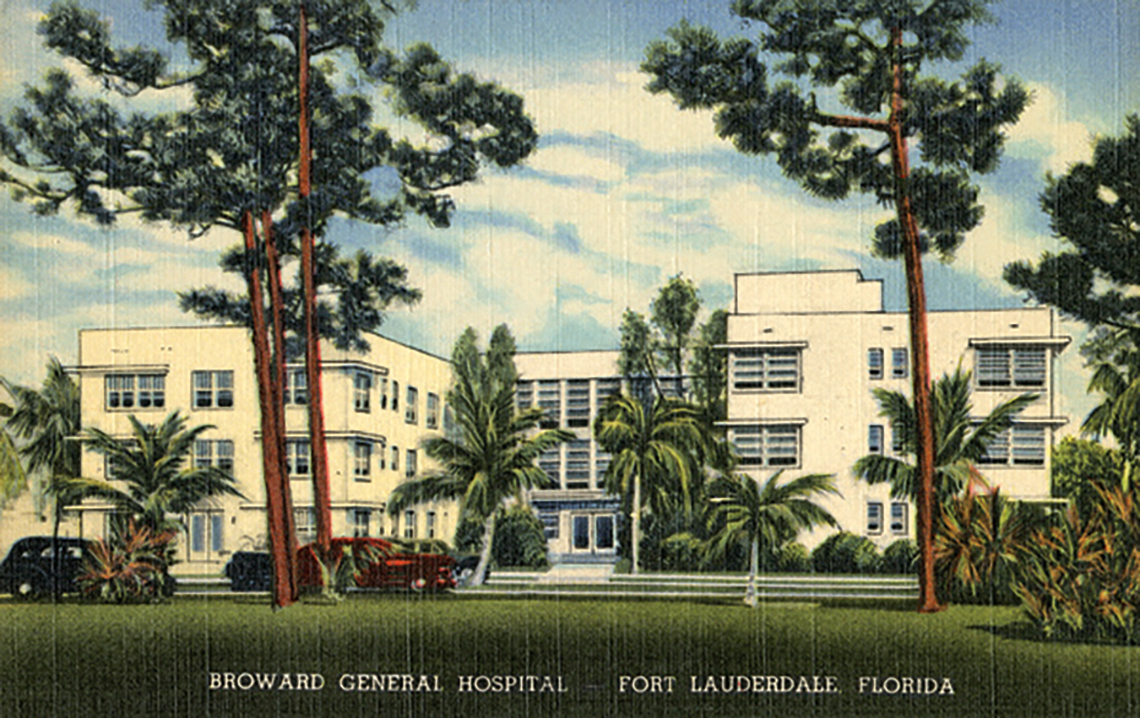
When I asked why my late grandfather, oft-referred to as a country doctor, stopped practicing medicine and went to work as a train conductor, the answer was swift.
“It’s hard to cover the bills when you get paid in chickens and canned tomatoes,” my dad explained.
I’m guessing it was kind of like that when Fort Lauderdale’s first hospital, a small private enterprise, closed down. Begun during the land boom of the early 1920s, it died in the land bust of the late ’20s. “Due to lack of patients able to pay for care, the [Edwards-Maxwell] hospital was forced to close in 1929,” one account reported.
It was not until 1938 that a community-based, public hospital – Broward General – was built.
Well, hold on now, it wasn’t really built. Strapped for cash, with no government help, a small group of community leaders and medical professionals did the next best thing.
They bought an old apartment building.
Presumably abandoned in the bust, this building was perfect for their needs. It was a standing structure with dozens of rooms. It had long, wide hallways with stairways at each end. And it cost only $26,000.
The Granada Apartments at Croissant Park off Andrews Avenue became Broward General Hospital.
It would just need a little architectural tailoring here and there.
You might think that, just like the old fort on the New River, this original site would fade away as decades came and went, public dollars became abundant and there was an increasing awareness of the value of – in the parlance of many years later – “state-of-the-art facilities.”
But you would be wrong. That three-story apartment building may have new wings, new towers, new parking lots, new satellite centers, new names like the North Broward Hospital District and today’s Broward Health. But the location has stood the test of time.
Architect Robert Jahelka drew up plans to convert the apartment building, and contractor George Young, Sr. did the renovation and remodeling. Both professionals did their work at cost and contributed their fees to a hospital fund.
Many others contributed furniture and supplies for the new effort. Doctors contributed medical equipment.
An early patient from Detroit, a winter resident needing a kidney stone removed, donated the building’s first air conditioner – for the operating room. No doubt it was sweltering before his gift.
The group that made this happen was led by James D. Camp, a banker and community leader, who was to become chairman of the hospital’s board. He and a number of doctors from throughout the city and county were convinced that they needed a community hospital over the uncertain standards of private efforts.
They formed the Broward Hospital Association, raising the Granada’s purchase price and contributing to a hospital fund. In 1938, Dr. R.L. Elliston tended to the first patient in the brand new 45-bed hospital.
The third floor featured the baby delivery room and operating room. The second floor had rooms for patients. The first had an emergency room, X-ray room, pharmacy and business office.
While we read in various accounts there was “a colored ward,” we know for a fact that black doctors were not allowed to practice there or at any other of the previous private hospitals in Fort Lauderdale. In this time of segregation, Dr. James Sistrunk performed operations in his own office.
But in that same year, 1938, Dr. Von D. Mizell, Dr. Sistrunk and others in the black community opened the doors to the 15-bed Provident Hospital in northwest Fort Lauderdale. Now they could at least operate on members of their own community in a normal medical setting.
It wasn’t until 1964, after suits by Dr. Mizell and other black doctors against the segregation in the Broward Medical Society, that they won the right to practice at Broward General.
Broward Health is now one of the 10 largest health systems in the country, with centers from Coral Springs to Weston. The former Broward General Hospital is now called the Broward Health Medical Center.
Broward Health Weston opened in the year 2000 at a price tag of $27 million.
Repeat, $27 million.
Tough funds to raise back in post-Depression days, but those Granada Apartments sure look like a steal at $26,000.











